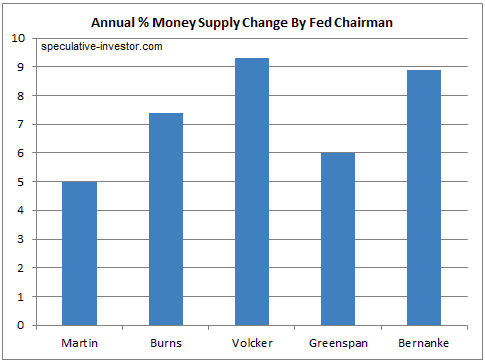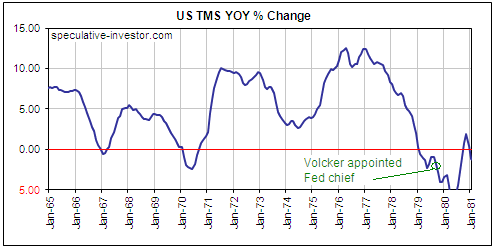There is a big difference between the general perception of Paul Volcker’s performance as Fed Chairman and his actual performance.
Volcker is generally considered to have been a hard-nosed inflation-fighter, but based on the annual rate of growth in US True Money Supply (TMS) he currently holds the record as the most inflationary Fed Chairman of the past 60 years. Ben Bernanke is in second place, followed by Arthur Burns (Fed chief during most of the 1970s), Alan Greenspan, and then William McChesney Martin (Fed chief during the 1950s and 1960s). Refer to the following bar chart for specific details.
Note that the chart omits George Miller, who was Fed Chairman for only 17 months during 1978-1979, and Janet Yellen, who hasn’t been in the job for long enough to establish a proper record.

Volcker is widely regarded as a hard-nosed inflation fighter simply because a commodity-price collapse got underway within 6 months of his August-1979 appointment as Fed Chairman. However, thanks to the steep decline in the money-supply growth rate that began in late-1977 and the fact that the US had spent the 6 months prior to August-1979 in monetary DEFLATION (refer to the following TMS chart for details), a commodity price collapse was ‘baked into the cake’ prior to Volcker taking the top job at the Fed .
If a drover’s dog had been appointed Fed chief in August of 1979, the dog would now have the credit for killing inflation. The reason is that by that time “inflation” (using the popular, albeit wrong, meaning of the word) was already dead. Commodity speculators just hadn’t realised it yet, perhaps because they were distracted by what was happening in the Middle East.

In the early 1980s, with a commodity bubble having recently burst and with both stocks and bonds having historically low valuations, the stage was set for the great ‘Volcker inflation’ to boost the prices of financial assets.
 Print This Post
Print This Post
